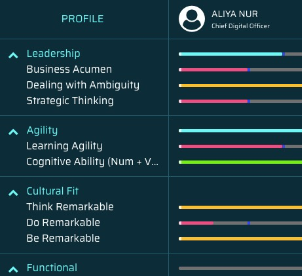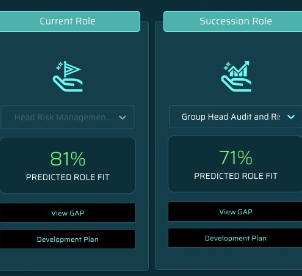What is Succession Planning?

The idea of having a leadership position suddenly become vacant can have disastrous impacts on groups, companies, and countries. A mainstream depiction of this can be seen in the widely popular American fantasy drama, Game of Thrones; every time a kingdom is de-kinged suddenly, a free for all war occurs from both internal and external forces wanting to grab the throne. Which is why many monarchs today take great importance is planning a rightful heir. Whilst not as dramatic as on TV, when organizations large or small fail proper succession planning the impact is just as harmful.
Succession planning has proven through time to be a practice that can make or break an organizations future and has also shown to be able to impact shareholder value overnight.
In today’s light, succession planning is not only a must have for organizations but must also evolve and be agile to adapt to demanding and constantly changing business environments.
We need to relook into our succession planning practices, repurpose why we do it and redefine what it means as a whole. We need to put a new lens to succession planning.
Traditional Succession Planning

The French Origin
The term “Succession Planning” unchanged in name until today, was actually introduced by a French pioneer of management history named Henri Fayol who developed a general theory of business administration called Fayolism. In his book Administration Industrielle et Générale or General and Industrial Management, Fayol developed 14 principles to management many still being used today. Amongst those are remuneration, tenure, team unity and of course, succession planning.
From the days of Henri Fayol to the wide research of William J. Rothwell and many more, Succession planning has now become a core component of long-lasting organisations. Whilst the definition of Succession Planning has expanded through the years, the fundamental idea remains the same; the right person, with the right skills, is placed in the right job at the right time.
3 Things To Do Away With
- Traditional Succession Planning

Whilst succession planning still remains vital in organizations today, it is important for organizations to adopt new and improved processes to better their succession planning. Traditional succession planning ways have downsides that severely impact leadership pipelines and development, eventually having a big impact on organizational success.
There are 3 key practices that companies need to revamp or do away with in order to groom the right person into the right roles.
- Subjectivity in decision making
- Promotion only on performance
- Succession planning only when required

1. Subjectivity In Decision Making
Organizations are sometimes faced with the need to make decisions with a lack of information or
data. When faced with this situation in making people decisions, subjectivity starts to creep in whether we realize it or not. Suggestions on who should succeed into a certain role and why they are good starts being formed by opinions instead of facts. Subjectivity can come in 2 forms:
Explicit – Knowingly being partial to a person and favoring them by choice
Implicit – Unknowingly being partial to a person driven by our mind’s preferences
Whilst conversations and opinions are always needed in succession planning, they should be driven by objective information such as data.

2. Promotion Only On Performance
Performance of an employee has historically been the single factor leading them to be considered a successor to a new role. Case studies and research now show us that whilst performance is an important metric, it should not be the only factor used in promotion. An employee performing well in their current role, may not necessarily be an indication they will do the same in the next role.
A succession planning case in Mattel Inc, the multinational manufacturing company shows us this. Jill Barad, who served as CEO from 1997-2000 was catapulted into the role due to her amazing track record in Marketing. However, her performance in Marketing did not give her insights into the financial and strategic factors in running a multinational company and resigned after a turbulent 3 years for the company. Many factors aside from performance should have been considered before Mattel succession planned.

3. Succession Planning Only When Required
Reserving succession planning for times when its only needed can have serious implications to organizational performance. Doing this not only means companies have to very quickly make a decision on candidates for the role, but also doesn’t give them time to train and develop a person properly. This can impact a person performance in the role, damper their morale and also cause shareholders to lose trust for the organization.
An organization that has done this right and shows that succession planning needs to be a planned and structured process is Apple. Steve Jobs worked hard to prepare Tim Cook for the role as CEO. Cook took on a variety of operational roles including manufacturing, distribution, sales, and supply chain management before working directly with Jobs to gain experience in the CEO role.
The Cost of Wrong Succession Planning

1. Financial Risk
The impact of a sudden departure or crisis for a key leadership role or mission critical position is significant and could cause disruption of the business. Some impact of business disruption includes issues such as suspended initiatives, disrupted third-party/partner relations, loss of revenue or shares and so on. There is a lot of uncertainty and turbulence posed from a sudden vacancy/departure of a key position within the organization. Studies show that companies without a proper succession plan forgo an average of $1.8 billion in shareholder value compared with companies that succession plan regardless of whether the replacement is an insider or outsider. For example, shares in Hewlett Packard took an 8.3% plunge after the CEO stepped down in 2010. However, this could be avoided if organizations have solid and effective succession planning in place.

2. The Wrong Candidate
When there is no structured process or success profile in place to determine what good looks like and selection is based on subjectivity or one-sided factors, whether hiring from internally or externally, there is always the risk of selecting the wrong candidate, someone who is not fully qualified, for a role. This happens even more so when there is an urgency to fill a vacancy quickly. The lack of a role fit, be it behaviourally, culturally, or skill-wise, would negatively influence the effectiveness and performance of someone in the role. According to the U.S Department of Labour, the cost of a wrong hire is at least 30% of the employee’s first year earning and this is an estimate of hard figures. There is also the element of morale and productivity of other employees that could potentially be affected on top of the quantifiable financial impact.

3. Lost Knowledge and Expertise
When a top talent leaves the company/role without a successor, the employee leaves taking with them all the knowledge and skillsets they have gained while in the role, in addition to the relationships built with stakeholders and how that could be leveraged to yield business results. For example, while hiring someone externally may fill the knowledge gap for the industry, but they require time to understand the dynamics and politics of the organization. The cost to replace a highly trained employee is expensive and could exceed 200% of their salary. Losing skilled employees in highly niche roles also increases the difficulty in finding a replacement externally due to the lack of talents in the market.

4. Losing Internal Talents
It is significantly cheaper for internal talents to success a role, as the organization can save time and recruitment fees. Furthermore, internal talents already come with institutional knowledge, as well as other relevant data that can be factored into the decision-making such as a performance track record, 360 feedback and assessment data. Promoting/hiring internal talents as part of career development and advancement opportunities can motivate and retain employees. As a result, this would strengthen their engagement and commitment to the organization, thereby increasing employee performance and talent retention. In contrast, organizations will lose out on these when there is no succession plan in place as it can be easy to overlook internal talents who are highly interested or suitable for a key position for external hires instead.
A New Lenses On Succession Planning

3 New Lenses
As we have seen, keeping certain areas in traditional succession planning, or even worse getting succession planning wrong overall can have a serious impact on organisations. Therefore, organisations need to be constantly ensuring their succession planning process is effective and efficient.
There is a fallacy that making succession planning constant and at scale however can cost organizations a lot of money. In fact, many business leaders and HR practitioners believe that succession planning is a complex process and practice restricted to the largest organizations with the most sophisticated organizational development departments.
These may have been through back in the day but with the constant evolution of HR platforms and increasing predictability of people analytics, succession planning can now be a scaled process without breaking the bank. Organizations who want the long-term performance and financial benefits of having a great succession planning program must now put a new lens on succession planning and understand how key areas of the process are now made better.
There are 3 new lenses organizations must have on succession planning moving forward.

1. Success Profiles
The most basic denominator for succession planning is jobs, not people. This means that when choosing a replacement, organizations must look at person to job fit instead of person-to-person comparison. The best successor would match the leadership competencies, cultural values, technical skills, and aspirations need for the job. However, HR sometimes finds this hard to do objectively because in today’s world jobs evolve and the skills needed for the job change quickly.
This is where organizations need to have a job architecture framework that houses all skills and competencies needed for each job in a central depository, simply put – Success Profiles. A validated depository of Success Profiles can very quickly give HR a view into all parameters needed for what good looks like for a role, and therefore now giving them visibility into the best person for the role.
A well-designed Success Profile gives visibility into different areas needed to perform at a role. An example below shows how success profiles break up competencies needed for a CDO into different areas.

2. Measurements & Visualization
Earlier we understood why performance should not be the only metric considered when making succession planning decisions, and with the introduction of Success Profiles we can clearly see what else needs to be measured. Next, organizations should find tools of measurements that provide an objective, fair and accurate result and also find a way to visualize the output.
Measurement
Measurement tools will allow organizations to understand the performance and potential of an individual making talent decisions more holistic. Organizations can match the tools they need with the relevant competencies in the Success Profiles. When deciding on measurement tools, organizations should look into qualifying criteria like predictive validity, reliability, mobile responsiveness, suitably across levels, engaging and etc.
Visualization
HR and business leaders today are expected to make people decisions much quicker than before, but without compromising accuracy. This is where the power to visualize data into insights fast becomes necessary. Manually matching your measurement data against success profiles to find the perfect candidates can be physically taxing, costly and present the possibility of human error. Instead, to scale, organizations must adopt dashboard that allow them to toggle filters they need and will visualize the appropriate talents for it.

3. Dedicated Platform
Upon having a Success Profile repository, measuring, and visualizing data, organizations must now make this process on-going, scalable, and forward looking. Ensuring succession planning becomes a year-round process at every job level needs a dedicated platform that culminates all talent information, guides career conversations with objective data present and allows for alignment between tomorrows talent and business strategy. This will also allow organizations to easily understand different role movements possible within an organizations and when exactly external talent is needed.
Organizations must take a new view on development and succession planning in that it does not necessarily mean an upward promotion but also lateral moves and aspired moves. Many talents leave organizations because of stagnancy due to not having an upward position available, but organizations who recognize this early are able to design different moves to retain their talent.
Creating the ability to move people in multiple ways via objective data based on validated Success Profiles not only increases an organizations succession plan readiness but helps grow internal mobility and talent management all contributing to high employee retention. More and more research show that holding multiple lateral roles in an organization contributes to high performance upon promotion. As well as that, research shows that a third axis aside from performance and potential, which is aspiration actually contribute to high performance. Having a platform to help manage this is what organizations need today.
Conclusion

Succession planning ensures business continuity by making sure the right people are put in the right positions to drive the company. Organizations who have ignored this or got succession planning wrong have paid hefty prices such as drop in shareholder value, year on year losses and even acquisitions. Take a new lens on succession planning to ensure your organization thrives
through change of roles and people.
Here are some places to start with if your organizations do not currently have a succession plan in place.
Start small and build: Rolling out an organization wide practice can be daunting, instead identify key revenue driving departments and start there leading into scale. Make it an organization objective: Create transparency and buy in by making succession planning an organizational goal not a HR program. Data, data, data: Remember to make all talent decisions objectively by having talent conversations driven by data.


